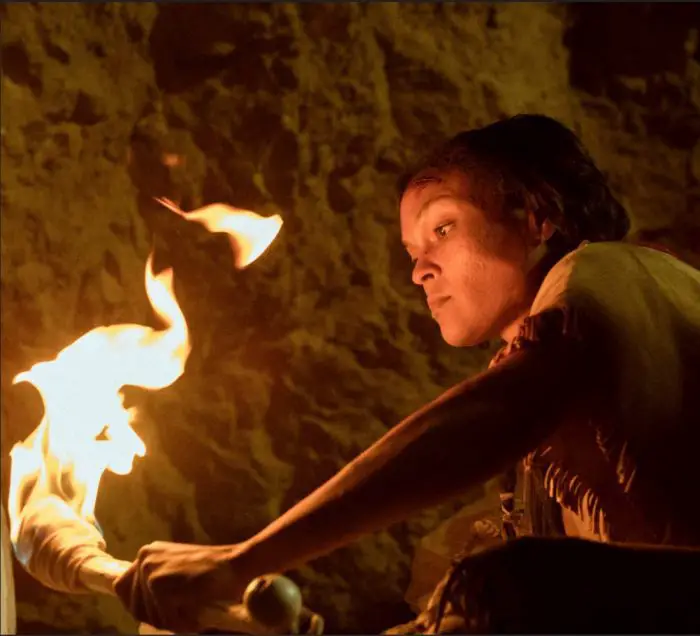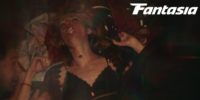As a horror film enthusiast, I watch a lot of independent films. I have to figure that many others are also this way, looking for something new and not as saccharin coated as the productions the top studios often produce. Lately, the horror-western subgenre has been very active. Netflix’s The Wasteland, AMC’s Dark Winds, Shudder’s The Pale Door, and at Grimmfest Easter, audiences saw Ghosts of the Ozarks. Isolation, paranoia, and distrust are part of a frontier lifestyle, and it’s made for some terrifying new folktales, and Blackwood ventures into this territory.
Blackwood tells the story of Dowanhowee (Tanajsia Slaughter), a native woman roaming through towns trading goods as the spirits guide her to the Black Wood Forest. When she sees a member of the Dutch Wilder (Bates Wilder) gang ride into town on a horse that once was hers, she decides to take it back. Murdering the member of the gang she believes responsible for multiple crimes against her, Dowanhowee reclaims her horse and sets out for Black Wood with the Wilder gang posse on her tail. When the gang catches up with her in the woods, an ancient creature is awakened, something Dowanhowee calls The Wendigo. Dutch and his crew will need Dowanhowee’s help if they plan on escaping the woods alive.

I felt like a kid in a rental store when I first read the synopsis of Blackwood. The unlikely duo angle had me thinking of The Good, The Bad, and the Ugly, where Blondie and Tuco team up against Angel Eyes, or Enemy Mine, where a human and alien are forced to cohabitate when stranded on a lifeless planet during a war between their worlds. Add in a Predator-lite plot of being lost in a forest with a supernatural being, and I was quickly sold on Chris Canfield’s debut feature.
Unfortunately, Canfield’s first film is far from perfect, but I think that can be said about many debut directorial efforts. Regardless, plenty of little moments within this horror western still shine. Viscera shots in the cold open and close-ups of fingernails ripping into wood reel the viewer in. It’s followed by a tense barroom scene, vigilante murder, and chase on horseback that keeps the blood pumping and your eyes glued to the screen. Even some of the atmospheric fog-filled locations add to the film’s appeal.
The breakneck pacing of Blackwood’s beginning wanes when the cast enters the Black Wood Forest. Reaching Canfield’s horror sandbox containing a monster that projects ghostly visions of the characters’ dead loved ones. This seems like a writer’s dream come true. However, whether creatively or budgetarily, the film decides to play it a lot slower, offering little excitement via scares and shocks until the climax. Like in Predator, the Dutch Wilder gang are hunted one by one, but we expect that. That’s generic “don’t go in the woods” horror, and what I was hoping for was more of a magic show from the arsenal of creative tricks Blackwood was already using. You can have a lot of fun when people can’t trust what they see. Now you see me. Now you’re dead.

If I think about it, it almost feels like the start of the film was written in (or re-written) after the fact to flesh out the story. The town is only used in one scene, with the rest set in a single location. The only reason it’s used is to introduce and round out the main characters a little more, but I think Blackwood achieves this better in momentary flashbacks in the woods, sharing stories around campfires, and outside of Dowanhowee and Dutch, the audience never emotionally connects. There are attempts with Lester (George Thomas Mansel) and Two Feathers (Casey Birdinground) to let their personalities come through and make them stand out more. Still, it’s difficult to see them as anything other than side characters and easy to know what their fates will be before getting to the climax.
The film’s wendigo monster isn’t anything particularly scary, but I give Canfield’s writing some credit for crafting a creature feature that adapts to the film’s budget and has it all make sense. Those expecting to see something more in line with Larry Fessenden’s 2001 film, Wendigo, will be sorely disappointed. Canfield’s story leans into a different interpretation of the wendigo lore, one where the monster is more human adjacent that can communicate with humans, though still partakes in cannibalism. Those that enjoy Native American legends and folktales may find Blackwood’s depiction of the supernatural entity a bit more realistic.
Themes of greed are often associated with this particular type of folklore. From the wendigo perspective, their cannibalistic urges leave them unsatisfied with a blood lust for more victims. Canfield bakes that into his story, with Dutch heading to the Black Wood Forest as part of a western gold rush effort and using the monster as a metaphor. It’s there, under the surface, but a lot of Blackwood’s morality lesson gets lost along the way.

On the technical end, there are some wonderfully achieved cinematography moments, the editing could be a little tighter in places, and the musical score primarily undoes much of the tone Canfield tries to accomplish by being bright and lively during action sequences when it needs to be ominous or foreboding. The performances aren’t bad, but occasional over-dubbing, like one of the first conversations between Dowanhowee and a small village trader, undo the illusion of the story. Multiple instances of unsynced audio exist in the film, seen again moments later during Two Feathers’ joke to the bartender in the saloon.
I also thought it was interesting how most of the names in the film reminded me of Red Dead Redemption II. Dutch, Henri, and Lester are characters in both, while Wallace Station is a location in the game and shares a name with another member of the Dutch Wilder gang in Blackwood. Maybe the intent is to draw players of the hit Rockstar game, which had 3.1 million active console players in 2020, and, honestly, it’s rather good marketing.
Overall, Canfield’s film is very uneven. The beginning and the ending contain a fair amount of entertaining action sequences that leave the viewer satisfied in the end, but getting the brakes pumped at the start of a lengthy filler of a second act will have many scrolling on their phones. I have to say the film delivered on its story in the end, but the film could have engaged its audience more in chilling ways. In a way, Blackwood misses the forest for the trees.
Blackwood arrives in theaters on July 22 and VOD on July 26.



